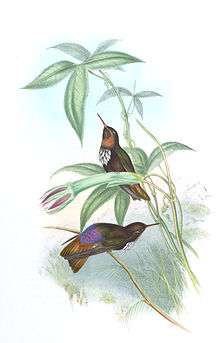White-tufted sunbeam
The white-tufted sunbeam (Aglaeactis castelnaudii) is a species of hummingbird in the family Trochilidae. It is found only in Peru. Its natural habitats are subtropical or tropical moist montane forest and subtropical or tropical high-altitude shrubland.[2]
| White-tufted sunbeam | |
|---|---|
 | |
| Painting by John Gould, for A Monograph of the Trochilidae (Family of Hummingbirds) | |
| Scientific classification | |
| Kingdom: | Animalia |
| Phylum: | Chordata |
| Class: | Aves |
| Order: | Apodiformes |
| Family: | Trochilidae |
| Genus: | Aglaeactis |
| Species: | A. castelnaudii |
| Binomial name | |
| Aglaeactis castelnaudii | |
Description
An adult white-tufted sunbeam is approximately 12 cm in height and weighs 7- 8.5 g. The bill is straight and black and there is a notable patch of white feathers directly under the chin on the breast. The rest of the body is described as tawny and darkly-colored. There are iridescent feathers on the back of the bird that are most noticeable in flight and while hovering. Males and females of the species exhibit subtle sexual dimorphism.[3]
Males are fuscous-black on their upper backs with a magenta reflection on their rump and lower back. Their tails are forked. The belly, side, and neck of a male are dull brown. The throat and pectoral band are blackish in color. True to their name, there is a white feather tuft on the central breast. Females are very similar to males, but have a less iridescent back and a smaller tail fork.[3]
Juvenile white-tufted sunbeams have a more uniform, brown exterior with no iridescent feathers.[3]
Habitat and range
The white-tufted sunbeam has a small and fragmented range, estimated at a maximum of 832 km2 (approximately 321 sq mi), cumulatively. This number was calculated using the remaining tree area in their range.[4] The species has been observed to have a range that is not restricted to a specific number of locations (i.e. the range is fragmented). These hummingbirds reside in two main areas located in Central and Southern-Central Peru. They prefer drier parts of evergreen montane forests, intermontane valleys, and open shrub.[5] White-tufted sunbeams can often be seen perching precariously at the very top of trees; except for where their range overlaps with Shining Sunbeams (Aglaeactis cupripennis). In these areas, they are often hidden away on lower branches and within dense vegetation.[6]
Vocalization
Like many hummingbirds, the white-tufted sunbeam has a very soft and inconspicuous call. Vocalizations include a repeated tzit call and, during chases, a twittering series of titi-tsreet-tsreet-tsreet sounds. The latter is used during hostile situations only. The white-tufted sunbeam can also emit a thin, high-pitched seeeuuu noise.[3]
Diet
Staples of this hummingbird's diet include flower nectar and insects. Some of the flowering plants utilized by this species include members of the following genera:
- Barnadesia
- Berberis
- Brachyotum
- Centropogon
- Labiatae
- Lupinus
- Salpichroa
- Siphocamplos
The white-tufted sunbeam is known for always clinging to flowers while it feeds and for catching insects in midair.[3]
Conservation status
This hummingbird's divided range meets the criterion of the IUCN (International Union for Conservation) Red List, and is therefore evaluated as near threatened. Despite a general agreement among researchers that this species has a declining population and fragmented range, it is not defined as vulnerable by the IUCN because the range is not considered severely fragmented.[2]
While the hummingbird's exact population size is unknown, white-tufted sunbeams have been described as “common but patchily distributed."[7] The suspected cause of population decline is ongoing habitat loss due to deforestation.[2]
References
- BirdLife International. 2017. Aglaeactis castelnaudii. The IUCN Red List of Threatened Species 2017: e.T22687791A118808695. https://dx.doi.org/10.2305/IUCN.UK.2017-3.RLTS.T22687791A118808695.en. Downloaded on 31 December 2018
- "Aglaeactis castelnaudii (White-tufted Sunbeam)". IUCN Red List of Threatened Species. Retrieved 2018-04-03.
- "White-tufted Sunbeam (Aglaeactis castelnaudii)". www.hbw.com. Retrieved 2018-04-04.
- Tracewski, Łukasz; Butchart, Stuart H.M.; Marco, Moreno Di; Ficetola, Gentile F.; Rondinini, Carlo; Symes, Andy; Wheatley, Hannah; Beresford, Alison E.; Buchanan, Graeme M. (2016-10-01). "Toward quantification of the impact of 21st-century deforestation on the extinction risk of terrestrial vertebrates" (PDF). Conservation Biology (in Spanish). 30 (5): 1070–1079. doi:10.1111/cobi.12715. ISSN 1523-1739. PMID 26991445.
- Parker, Theodore A.; O'Neill, John P. (1980). "Notes on Little Known Birds of the upper Urubamba Valley, Southern Peru". The Auk. 97 (1): 167–176. JSTOR 4085817.
- "White-tufted Sunbeam - Introduction | Neotropical Birds Online". neotropical.birds.cornell.edu. Retrieved 2018-04-04.
- Stotz, Douglas F. (June 1996). Neotropical Birds: Ecology and Conservation. University of Chicago Press. ISBN 9780226776309.
